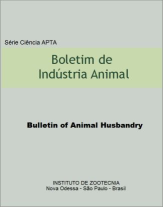Performance of jersey and holstein heifers in marandu palisadegrass pastures during the implantation of silvopastoral system with african mahogany
Palabras clave:
Uroclhoa brizantha, grazing, weight gainResumen
In Brazil, each year there is a significant increase in the volume of milk produced. The correct pasture management influences the weight gain of dairy heifers, which consequently enables a better sexual maturity, resulting in a better yield in milk production. Allied to this, the silvopastoral system can help in the recovery of degraded pastures. This research aimed to evaluate the weight daily gain of Holstein and Jersey heifers in Marandu Palisadegrass pastures with intermittent defoliation during the implantation of silvipastoral system with African Mahogany. The experiment was conducted at Instituto de Zootecnia in Nova Odessa, São Paulo, Brazil. African Mahogany seedlings were planted from December/2015 to February/2016. Treatments consisted in two heifer dairy breeds (Holstein and Jersey), in integrated Marandu Palisadegrass sward swith African Mahogany with three rows (5 x 5 x 5 m between trees) or one row (5m between trees) trees, spaced 15 m apart (4,500 m2 Marandu Palisadegrass paddocks), in a complete randomized block design with three replications, in a 2x2 factorial design. 48 Holstein and Jersey heifers with initial body weight of 180 and 135 kg respectively were evaluated in rotational stocking grazing management (25 cm pre-grazing height and 15 cm post-grazing height) from May to July/2016. The animals were weighed every 28 days. Two heifers from each breed were selected as tester heifers, and remained grazing in the treatment all the period long, and their weight gain was used for the calculation of the weight daily gain (kg.day-1). Data were subjected to analysis of variance using PROC MIXED of SAS® (Statistical Analysis System, version 9.3) statistical package. The means of the treatments were estimated using the "LSMEANS" and the comparison between them performed by Student t test (P <0.05). There was difference between breeds (P= 0.0345) in the weight daily gain. Holstein heifers had a higher gain (0.3097 Kg.day-1) compared with Jersey heifers (0.2355 Kg.day-1), being 31.5% higher. Possibly for the higher dry matter intake, better feed conversion and difference between genotypes. Primavesi (2004) found lower values using Holstein heifers in Brachiaria decumbens pastures in summer (0.198 kg.day-1) and in autumn (0.157 kg.day-1). Moreno (2008) analyzing Jersey breed in Ryegrass pasture in a continuous grazing system found weight daily gain of 0.580 kg. The number of African Mahogany rows didn€™t influence the average weight daily, probably because they were with 36 cm average height, without interference in pasture growth neither in the thermal comfort.
Descargas
Descargas
Publicado
Número
Sección
Licencia
Os autores não serão remunerados pela publicação de trabalhos, pois devem abrir mão de seus direitos autorais em favor deste periódico. Por outro lado, os autores ficam autorizados a publicar seus artigos, simultaneamente, em repositórios da instituição de sua origem, desde que citada a fonte da publicação original seja Boletim de Indústria Animal. A revista se reserva o direito de efetuar, nos originais, alterações de ordem normativa, ortográfica e gramatical, com vistas a manter o padrão culto da língua e a credibilidade do veículo. Respeitará, no entanto, o estilo de escrever dos autores. Alterações, correções ou sugestões de ordem conceitual serão encaminhadas aos autores, quando necessário. Nesses casos, os artigos, depois de adequados, deverão ser submetidos a nova apreciação. As opiniões emitidas pelos autores dos artigos são de sua exclusiva responsabilidade. Todo o conteúdo deste periódico, exceto onde está identificado, está licenciado sob a Licença Creative Commons Attribution (CC-BY-NC). A condição BY implica que os licenciados podem copiar, distribuir, exibir e executar a obra e fazer trabalhos derivados com base em que só se dão o autor ou licenciante os créditos na forma especificada por estes. A cláusula NC significa que os licenciados podem copiar, distribuir, exibir e executar a obra e fazer trabalhos derivados com base apenas para fins não comerciais.













